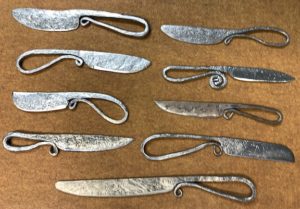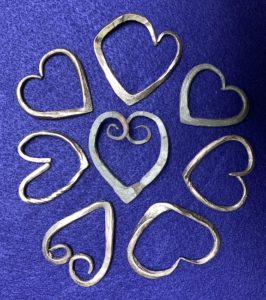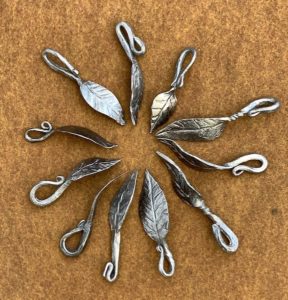by Phil Dwyer | HS Teacher
Most of what we use in our modern world can be traced back to the fires of a blacksmith’s forge. Most crafts and trades either began or evolved with the forming of hot iron under the blacksmith’s hammer. The most fundamental impact, of course, was on food production. With the introduction of iron farm implements crop yields increased, which enabled the dense population clusters of cities, which in turn gave birth to urban trades. The flip side also included ever increasing capacities of weapons production and usage. Thus the twin threads of our heritage have come down through the ages: progressive creative collaboration along with destructive conflict and confrontation.
 Just a handful of generations ago our entire modern world was crafted, created, and maintained within the fire-breathing realms of smithies (blacksmith shops). As recently as the American Civil War, steel products were still manufactured at the ends of blacksmiths’ hammers. Not long ago our hometowns, villages, and city blocks were populated with the industrious and critically important smithies. It is mind boggling that what was so incredibly prevalent not many life spans ago became nearly extinct almost overnight.
Just a handful of generations ago our entire modern world was crafted, created, and maintained within the fire-breathing realms of smithies (blacksmith shops). As recently as the American Civil War, steel products were still manufactured at the ends of blacksmiths’ hammers. Not long ago our hometowns, villages, and city blocks were populated with the industrious and critically important smithies. It is mind boggling that what was so incredibly prevalent not many life spans ago became nearly extinct almost overnight.
 In recent years there has been a renewal of blacksmithing, especially in the artistic and architectural realms. Waldorf high schools have long known about the many wonders of the craft. When students take up the hammer and thrust iron into the flame, they do more than just make a metal gadget. They step onto the primal path of our very being as modern humans. Every time high school students move heavy steel anvils, forges, and tool racks, they do more than just set up the shop. When they approach the fury of the forge to place their cold iron in it, stand beside it to monitor its heating progress and remove the iron glowing bright orange, they do more than just simply heat iron. When they pick up the cross peen hammer, lift it high over their heads, and forcibly swing it down to strike the searing steel, they do more than just pound metal. When they reheat the iron as hot as they can without letting it burn, they do more than just watch for the right color. When they take blazing metal and clamp it into the solid upright post vise to twist and bend it, they do more than just shape it. When they render these activities, blacksmith students join the ranks of ancient alchemists and crafters as well as modern technicians and artists.
In recent years there has been a renewal of blacksmithing, especially in the artistic and architectural realms. Waldorf high schools have long known about the many wonders of the craft. When students take up the hammer and thrust iron into the flame, they do more than just make a metal gadget. They step onto the primal path of our very being as modern humans. Every time high school students move heavy steel anvils, forges, and tool racks, they do more than just set up the shop. When they approach the fury of the forge to place their cold iron in it, stand beside it to monitor its heating progress and remove the iron glowing bright orange, they do more than just simply heat iron. When they pick up the cross peen hammer, lift it high over their heads, and forcibly swing it down to strike the searing steel, they do more than just pound metal. When they reheat the iron as hot as they can without letting it burn, they do more than just watch for the right color. When they take blazing metal and clamp it into the solid upright post vise to twist and bend it, they do more than just shape it. When they render these activities, blacksmith students join the ranks of ancient alchemists and crafters as well as modern technicians and artists.
High school blacksmith classes are considered practical and applied arts courses. Students apply their academic studies in practical ways in the smithy. The sciences are obviously at home there, such as thermal dynamics, mechanics, and chemistry. So too, are the arts and the aesthetics of function and form. The humanities with their cultural and historical context are equally at home in the smithy. Perhaps even more so, but a bit less obvious, the physical, psychological, and inner lives of blacksmith students are well exercised at the forge and anvil. Blacksmithing supports and strengthens physical body growth, coordination, and agility. Students gain a practical understanding of and appreciation for metal, as well as develop skills and confidence with tools and basic machinery. To craft a piece of raw steel with one’s labor into a functional item of beauty is a nourishing activity in other ways, too.
 To work directly with the four most basic of “elements,” earth, fire, air, and water, not only has drama and excitement, it has power and danger! To transform one’s fear of danger into respect and confidence through one’s own disciplined efforts is a noble and worthwhile deed. The firsthand knowledge and experience of having made such a transformation—from the daunting to the capable—lives on in the students. The ability to develop capacities gives students navigational ballast throughout life. Additionally, awareness and mindfulness are two more capacities that are imperative for students to develop in the smithy. Sharing a workspace safely while swinging hammers and wielding hot steel compels students to be awake to self and others at all times. This is undertaken as a social deed with one’s classmates.
To work directly with the four most basic of “elements,” earth, fire, air, and water, not only has drama and excitement, it has power and danger! To transform one’s fear of danger into respect and confidence through one’s own disciplined efforts is a noble and worthwhile deed. The firsthand knowledge and experience of having made such a transformation—from the daunting to the capable—lives on in the students. The ability to develop capacities gives students navigational ballast throughout life. Additionally, awareness and mindfulness are two more capacities that are imperative for students to develop in the smithy. Sharing a workspace safely while swinging hammers and wielding hot steel compels students to be awake to self and others at all times. This is undertaken as a social deed with one’s classmates.
Making hard steel malleable with jets of air and fierce fire, shaping searing steel with anvil, hammer, and hand, quenching forged steel in water, sizzling and hissing, students become smiths of iron in parallel with the forging of their very selves! It is quite moving to behold their progress from hesitant, tentative work to bold, eager, and skilled execution. After all, it is no small feat to stand steady in the midst of the mighty forces of intense forge fires in tandem with hormonal surges and blooming neural networks. Our high school blacksmith students do it with aplomb and merit our applause!
…Thus at the flaming forge of life
Our fortunes must be wrought;
Thus on its sounding anvil shaped
Each burning deed and thought.
— from The Village Smithy, Henry Wadsworth Longfellow

